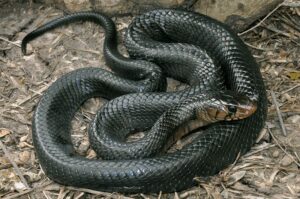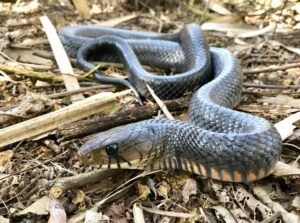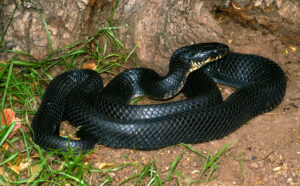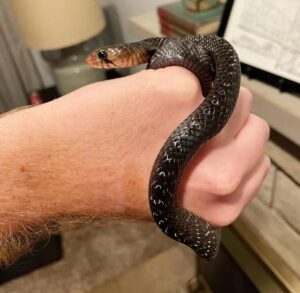Texas Indigo Snake (Drymarchon melanurus erebennus)
Updated on
25/04/2024The Texas indigo snake is a subspecies of the Middle American indigo snake. The solitary colubrid is endemic to Texas and adjacent Mexico. The active, diurnal hunter hides in burrows made by other animals at night. It is among the largest snakes in the United States. It owes its name to its very shiny scales that reflect an iridescent blue-purple hue in light.
Scientific Classifications
- Suborder:Serpentes
- Family: Colubridae
- Genus:Drymarchon
- Species:D. melanurus
- Subspecies:D. m. erebennus
Conservation Status
Description
Size
Most of these snakes attain a total length beyond 6 ft (1.8 m). 8 ft (2.4 m) long specimens can even be found.
Color and Appearance
The Texas indigo snake is predominantly black on its dorsal side. The high sheen of its dorsum gives its smooth scales an attractive iridescent shade. The underside is often of a salmon-pink color.
Are They Dangerous to Humans
Though typically a non-aggressive and docile snake, it may bite strongly or give off a foul-smelling musk from its cloaca if harassed or handled. But before attacking, the serpent often shakes its tail as a warning though it lacks a rattle.
Texas Indigo Snakes at a Glance
Distribution
This snake ranges from southern Texas south into Mexico up to Veracruz.
Habitat
It prefers lightly vegetated lands not far from permanent sources of water. But it is also found in open grassland areas, mesquite savannahs, and coastal sand dunes.
It is a threatened subspecies due to habitat loss caused by developmental projects. Each Texas indigo snake requires a huge home range to hunt, but urban sprawl has reduced its usable habitat. Roads dissect their territories causing many to die as a result of getting run over by cars.
Lifespan
It is estimated to have a lifespan of 9-15 years.
Predators
Birds of prey feed on the Texas indigo snake. But humans are the greatest threat to the serpent.
Diet
The colubrid eats almost anything it can overpower and swallow – birds, mammals, frogs, lizards, turtles, eggs, and other snakes, including rattlesnakes.
Its aggressive attacks on rattlesnakes have led many south Texas farmers to consider it a helpful ally. Hence the adage goes, “If it’s an indigo, let it go”. It kills rattlesnakes using the brute force of its strong jaws and tolerance to the latter’s venom.
Reproduction
Oviparous (lays eggs that hatch outside the body)
The subspecies usually breeds yearly, in the winter. Clutches with an average of 10-12 eggs laid in the spring that take around 80 days to hatch. The hatchlings measure 26 in (66 cm) and reach sexual maturity in 2-3 years.
Similar Species
The eastern indigo snake, Drymarchon couperi, has blue-black scales. On the other hand, the Texas indigo sake appears black but is usually mottled. Plus, it has a pinkish venter that is absent in the eastern indigo snake.
Care Sheet
Size of the Enclosure: The minimum size of the cage should be 6’ (length) x 2’ (width) for housing an adult Texas indigo snake.
Temperature: The ambient temperature of the pet setup should be maintained at 70-78°F. The temperatures on the cool side of the cage should never exceed the low 80s. The hot spot can be kept in the mid-80s.
Humidity: The required humidity levels can be provided by misting the cage daily without oversaturating the substrate. The general rule of thumb here is the moisture from the misting should dry out over the night to avoid mildew or mold formation in the cage. The pet setup should include a small water dish that doesn’t tip over.
Substrate: Newspaper, and peat moss can be used as the substrate. A hide box with slightly damp sphagnum moss may be provided to maintain the humidity levels in the enclosure.
Feeding: They can be given chicken necks, chicks, fish, quail, mice, rats, and other snakes. All food should be frozen, thawed, and proportionately small in size.
Source
i.pinimg.com, flickr.com, a-z-animals.com, reddit.com









